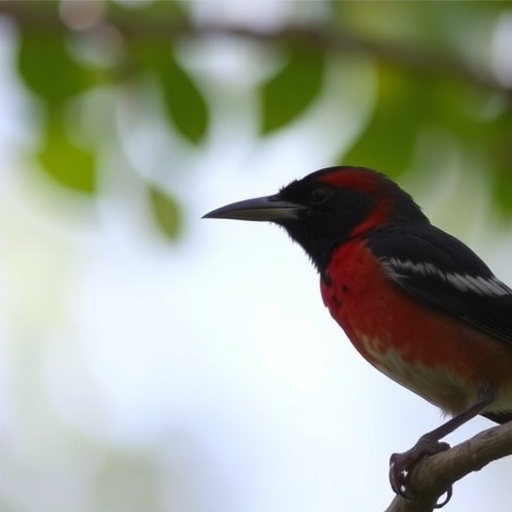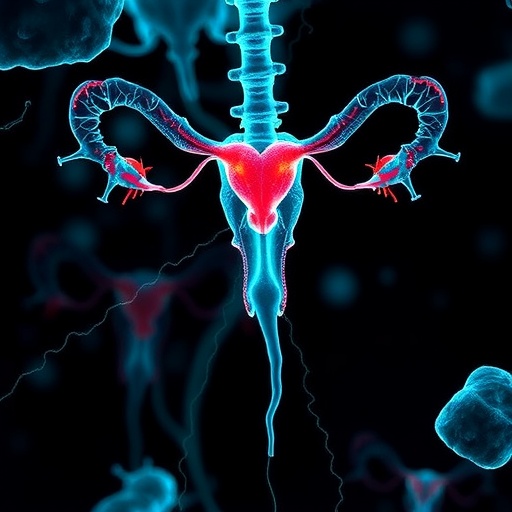In a groundbreaking discovery that challenges traditional boundaries between instinct and learning in animal communication, researchers from Cornell University and the Donana Biological Station in Seville, Spain, have revealed that birds separated by immense geographical distances and millions of years of divergent evolution share an astonishingly similar warning vocalization. This vocalization functions as a learned yet biologically rooted signal to identify parasitic threats near nesting sites, signifying a pivotal synthesis of innate and acquired behavior hitherto undocumented in the animal kingdom. Their findings, set for publication in Nature Ecology and Evolution on October 3, 2025, provide compelling insights into how natural selection sculpts vocal communication by blending inborn responses with socially transmitted learning.
Brood parasitism poses an extraordinary evolutionary challenge for avian species. Certain parasitic birds such as cuckoos circumvent the taxing duties of parental investment by stealthily depositing their eggs into the nests of other bird species. This parasitic stratagem compels the host birds to rear offspring that are not their own, often at debilitating costs to their biological progeny. Consequently, selection pressure has driven host species toward the evolution of highly specialized behaviors aimed at detecting and thwarting such incursions. This study illuminates one key aspect of this defense: a shared “whining” call emitted by more than twenty bird species across four continents whenever parasitic birds encroach on their territories.
The discovery that birds from disparate regions, including Australia, China, and Zambia, independently employ such acoustically similar vocal warnings is both bewildering and revolutionary. Unlike a scenario where geographical proximity facilitates cultural transmission, these species have never met, nor shared habitats, suggesting that this common vocalization arises from intrinsic biological mechanisms. The researchers propose that the initial production of the signal is born from an innate reflex — a hardwired sound-meaning association — which becomes shaped and refined through social interactions known as social transmission. This dynamic allows young or naive birds to learn the precise contextual deployment of the call, thus bridging the divide between instinct and learned vocal repertoire.
James Kennerley, a postdoctoral fellow at the Cornell Lab of Ornithology and co-lead author, explains that when a bird first hears this whining warning, it instinctively investigates its source. It is through this investigative behavior that the individual bird absorbs environmental cues and fine-tunes the conditions under which it will make the call in future encounters. This process of learning is critical to the efficacy of the vocalization, reflecting a complex integration of inborn signaling instincts with experience-driven modulation. The result is a communication system neither wholly innate nor entirely learned but a sophisticated hybrid of the two.
William Feeney, an evolutionary ecologist from the Donana Biological Station and co-lead researcher, emphasizes the significance of this hybrid vocalization. He characterizes the whining call as inhabiting a middle ground between rigid, genetically programmed animal vocalizations and the fully flexible, culturally transmitted vocal units characteristic of human speech. This finding illuminates a long-sought evolutionary intermediary—providing empirical support to Darwinian notions that the emergence of complex vocal communication may hinge on incremental blending of innate impulses and learned behaviors.
Further analysis revealed that species producing these whining calls typically inhabit ecosystems characterized by intricate interspecies networks involving multiple brood parasites and host species. This ecological complexity intensifies the evolutionary arms race between parasitic invaders and cooperative hosts, promoting the rise of vocal signals that facilitate coordinated defense strategies. Kennerley points out that cooperative communication frameworks are especially crucial where cooperative efforts among birds are necessary to effectively repel parasites, thereby suggesting a powerful role for social learning and vocal signaling in maintaining these intricate alliances.
This dual nature of the whining call—an inherent vocal template refined by learned contextual use—uncovers new paradigms in understanding the evolutionary pathways of animal communication systems. It indicates that vocal signals can evolve through selective pressures that shape both neurological predispositions and socially acquired competencies. This insight may redefine the conceptual boundaries that have traditionally compartmentalized animal calls as either reflexive or purely learned, demonstrating instead a continuum of vocal plasticity.
The implications of this study extend beyond avian communication, posing challenging questions about the origins of language itself. By documenting how birds assign learned meaning to an otherwise innate sound template, the study suggests parallels to the evolution of human language, which likewise integrates inherited neurobiological structures with culturally mediated learning. This gradation from instinct to language echoes hypotheses long proposed by linguists, cognitive scientists, and evolutionary theorists, providing vital empirical evidence that animal vocalization systems may be ontogenetic and phylogenetic precursors to human speech.
Moreover, these findings contest the entrenched dichotomy that separates human language as unique and categorically different from animal communication. They underscore the possibility that certain animals possess the evolutionary and cognitive capacities to utilize learned vocalizations in ways akin to linguistic behavior. This challenges researchers to reconsider how signals can acquire meaning through social interactions and how complex communication systems may evolve under variable ecological and social conditions.
The worldwide ubiquity and functional convergence of this whining call among an array of bird species underscore the adaptive significance and power of natural selection in shaping vocal communication. The interplay between socially learned and innate components of the call ensures both reliability and flexibility, optimizing survival outcomes in the context of brood parasitism — a vivid demonstration of how evolution negotiates the tension between stability and innovation.
In a broader context, this research opens new avenues to investigate the mechanisms underlying communication systems in other animals, potentially uncovering similar intermediate stages that bridge innate and learned vocal behaviors. Such insights are critical not only for ethology but also for developing conservation strategies, especially in environments where species interactions are rapidly changing due to ecological disruption.
By elucidating how non-human animals can use innate vocal signals modified through learning to coordinate cooperative defenses, this study redefines our understanding of animal intelligence, social dynamics, and communication. The seamless integration of these vocal signals into the social fabric of birds facing parasitic threats represents an extraordinary example of evolutionary innovation and adaptability.
As researchers continue to decode the evolutionary history of vocal communication, findings like those presented in this study are pivotal, offering a glimpse into the incremental steps that may have ultimately led to the emergence of complex language in humans. By bridging the gap between innate vocal repertoires and learned language-like communication, scientists are peeling back some of nature’s deepest secrets about the origin and evolution of meaning-bearing sounds.
Subject of Research: Vocal communication and evolutionary biology of birds in the context of brood parasitism
Article Title: Learned use of an innate sound-meaning association in birds’
News Publication Date: 3-Oct-2025
Web References: http://dx.doi.org/10.1038/s41559-025-02855-9
Keywords: Language history, Linguistics, Language evolution, Social sciences, Birds, Animals, Life sciences
Tags: birds vocal communicationbrood parasitism in avian speciesCornell University bird researchevolutionary biology of bird communicationevolutionary challenges in bird speciesinnate versus learned behaviors in animalslearned vocalizations in birdsnatural selection and vocal signalsorigins of language in animalsparasitic threats to nesting birdsparental investment strategies in birdssocial learning in animal behavior






